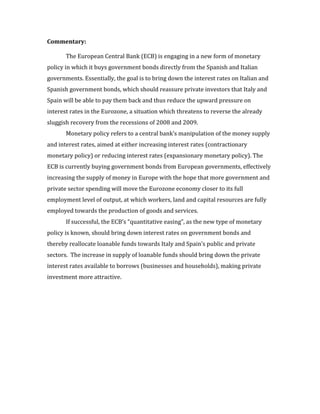
Commentary
- 1. Commentary: The European Central Bank (ECB) is engaging in a new form of monetary policy in which it buys government bonds directly from the Spanish and Italian governments. Essentially, the goal is to bring down the interest rates on Italian and Spanish government bonds, which should reassure private investors that Italy and Spain will be able to pay them back and thus reduce the upward pressure on interest rates in the Eurozone, a situation which threatens to reverse the already sluggish recovery from the recessions of 2008 and 2009. Monetary policy refers to a central bank’s manipulation of the money supply and interest rates, aimed at either increasing interest rates (contractionary monetary policy) or reducing interest rates (expansionary monetary policy). The ECB is currently buying government bonds from European governments, effectively increasing the supply of money in Europe with the hope that more government and private sector spending will move the Eurozone economy closer to its full employment level of output, at which workers, land and capital resources are fully employed towards the production of goods and services. If successful, the ECB’s “quantitative easing”, as the new type of monetary policy is known, should bring down interest rates on government bonds and thereby reallocate loanable funds towards Italy and Spain’s public and private sectors. The increase in supply of loanable funds should bring down the private interest rates available to borrows (businesses and households), making private investment more attractive.
- 2. The ECB’s bond purchases make it cheaper for Italy and Spain to borrow, lowering the interest rates on their bonds, restoring confidence among international investors, who may be more willing to save their money in Italy in Spain. The inflow of loanable funds into these economies (seen as an increase in the supply of loanable funds from S1 to S2) should bring down private borrowing costs (the real interest rate), encouraging more firms to invest in capital and more households to finance the consumption of durable goods, increasing aggregate demand and moving the Eurozone economy back towards its full employment level of output, from AD1 to AD2 in the graph on the right. In certain circumstances, monetary easing like this could be inflationary, but in reality inflation is unlikely to occur given the large output gap in Europe at present (represented above as the distance between Y1 and the dotted line, signifying the full employment level of output). Any increase in aggregate demand will lead to economic growth (an increase in output), but little or no inflation due to the excess capacity of unemployed labor, land and capital resources in the European economy today. With private sector borrowing costs increasing due to growing uncertainty over their deficits and debts, the Italian and Spanish governments will find expansionary fiscal policies (tax cuts and increased government expenditures) are unrealistic options for achieving the goal of full employment. The ECB, however, as
- 3. Krugman argues, should continue to play an increasing role in the expansion of credit to cash strapped European governments, with the aim of keeping interest rates low to prevent the crowding-out of private spending that often occurs in the face of large budget deficits. Inflation, always a concern for central bankers, should be a low priority in Europe’s current recessionary environment. Only when consumer and investor confidence is restored, a condition that requires low borrowing costs, will private sector spending resume and the Euro economies can begin creating jobs and increasing their output again. In the short-term, Italy and Spain should take advantage of the ECB’s bond- buying initiative, and make meaningful, productivity-enhancing investments in infrastructure, education and job training. If their economies are to grow in the future, Eurozone countries must become more competitive with the rapidly expanding economies of Asia, Eastern Europe, and elsewhere in the developing world. In the medium-term, the Eurozone countries must demonstrate a commitment to fiscal restraint and more balanced budgets. Eliminating loopholes that allow businesses and wealthy individuals to avoid paying taxes, for example, is of utmost importance. Also, increasing the retirement age, downsizing some of the more generous social welfare programs and increasing marginal tax rates on the highest income earners would all send the message to investors that these countries are commited to fiscal discipline. Then, in time, their dependence on ECB lending will decline and private lenders will once again be willing to buy Eurozone government bonds at lower interest rates, allowing for continued growth in the private sector.